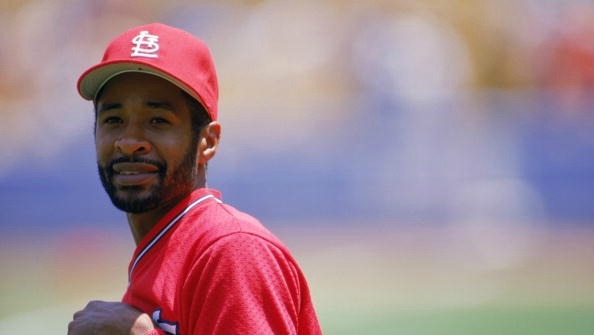Chance the Rapper's brown and white baseball cap matched his suit. It shaded his eyes from the spotlight when he accepted three Grammy awards Feb. 12.
Earlier that day, designers for Public School dressed models in a familiar firetruck-engine red hat for the New York Fashion Week runway.
Just this past Saturday, a couple donned Nike headgear at Queen City Radio in Over-the-Rhine. Black-and-white his-and-hers.
They watched the flat screen above the bar. It broadcast the Gonzaga basketball players' celebration on the court, each sporting a Nike cap coordinating with their trophy.
The next afternoon, President Donald Trump wore his red cap at a golf course in Virginia.
And Sunday, when the St. Louis Cardinals and Chicago Cubs take the field at Busch Stadium for Opening Day, they will all likely be wearing fresh, fitted hats. Even though there is no specific Major League Baseball rule requiring them to do so.
The modern-day baseball cap is a national tradition, a ritual on and off the field.
It's worn almost everywhere by just about everyone. Last year, New Era Cap Company produced 65 million baseball caps in sizes small enough for a Chihuahua (4.5) and large enough for a linebacker (8.5).
Sure, it's an easy way to cope with a bad hair day. It's inexpensive and comfortable. And it always will serve its original function: to keep the sun out of our eyes.
Most of us look good in it, too, said Brooke Brandewie, assistant professor at the University of Cincinnati's School of Design. "It frames your face and calls attention to your eyes."
But the cap is more than that.
Since the late 20th century, the baseball cap has topped off the American uniform. And it seems to be cut from a fabric that is both classless and timeless.
Think about it
What else do pop stars and presidents, grandfathers and grandsons all grab before they leave the house? What else will you find on the sidewalk and the runway, a cornfield and a red carpet?
Caps help tell our country's story. Look at the Smithsonian Institution's National Museum of American History collection.
There, you'll find Willie Stargell's Pittsburgh Pirates cap from the 1979 World Series. Tom Selleck's Detroit Tigers cap in "Magnum, P.I." The hat former New York City Mayor Rudy Giuliani wore on Sept. 11, 2001.
Simply put, the baseball cap is a symbol for America because baseball is a symbol of America.
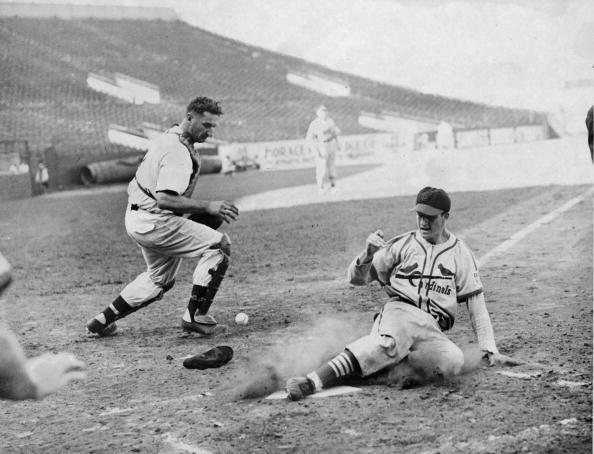
It hasn't been the most popular sport in this country for some time. But it's never stopped being called the national pastime because it can never stop being the oldest original American sport.
Maybe Americans wear so many sports-born styles, like sneakers and the baseball cap, because it makes us feel like we are part of a team, said Robin Givhan, The Washington Post’s fashion critic.
A baseball cap "connects you with people in a broader way," Givhan said. "I think so much of fashion really is about finding your identity in the broader world."
It "allows you to self-identify ... It's a shorthand for being able to announce an allegiance."
One size did not fit all
The first baseball teams of the mid-19th century, however, did not wear hats to declare a loyalty to a certain team, city or idea.
They didn't even match.
Those pioneers grabbed whatever hat they would normally wear outside when they headed out to the field. "If you were outdoors in the mid-1800s engaged in physical activity, you wore a hat," said John Thorn, Major League Baseball's official historian.
As clubs matured, leaders understood that players had to look like a team to be a team. So they borrowed a uniform design from another group. Firemen, actually.
And the fireman's hat?
That had a "boxy, short, flat brim," Thorn said. "This was not particularly helpful, and modifications were made."
On April 24, 1849, the New York Knickerbockers became the first baseball team to adopt an official uniform, including a straw hat, according to the National Baseball Hall of Fame.
Still, there was a tremendous variety of hats worn. There were floppy hats, Thorn said, that were more like shapeless baker hats. A jockey-style hat. Even something that looked a bit like a cross between a fez and a beanie worn out of Chicago.
The pillbox – that's the red-and-white striped cap the Mr. Redlegs mascot sports today – was certainly in that hat rotation.
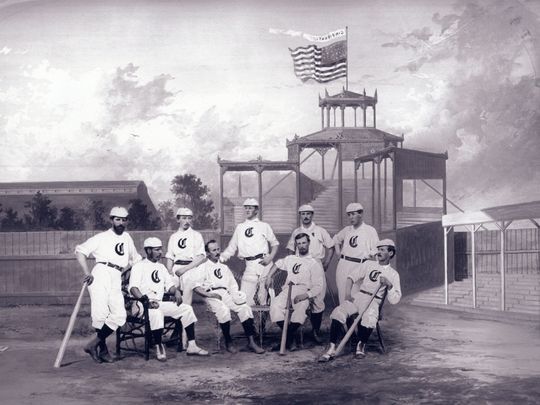
In 1868, the Cincinnati Red Stockings posed for a portrait wearing a sort of jockey-style cap with a very short brim. This was taken one year before the squad went professional, the first of its kind.
"Spalding's Official Baseball Guide," published 20 years later, featured no less than 10 different cap styles for sale. "That was an area of freedom," Thorn said. "They wished to be distinctive though part of the same league.
Survival of the fit
The baseball cap, with its bill and paneled crown, was in the mix from as far back as the 1860s, Thorn said. Look at the amateur club the Brooklyn Excelsiors, formed in 1854. That club wore a six-paneled cap, with a high crown. It's an obvious ancestor of the contemporary cap.
The cap's evolution is a natural one, Thorn noted.
"We had 100 species and now we have one."
In 1934, New Era created its first professional baseball cap for the Cleveland Indians. Twenty years later, the headwear company introduced a fitted cap known as the 59Fifty. And that's what every ball player wears today.
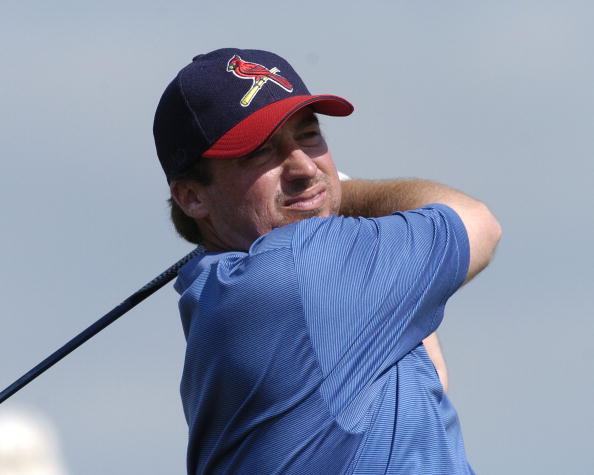
So why did the New Era design prevail in the survival of the fittest? The fit of the cap, for one. The quality and customization, too, said Dana Marciniak, director of the company’s press relations and brand communications.
The 59Fifty is still the company's most popular product. But baseball doesn't own the style. New Era holds the license for over 500 sports, companies and brands, including the NFL, Disney and Hello Kitty.
So how and when did the baseball cap make the leap out of the ballpark? Thorn said that started in the 1950s and it started with kids. He knows because he was one of them.
"You can tie it to television," he said.
TV was the only ticket you needed for the Hank Aaron or Frank Robinson show.
With the expansion of the Little League in the late 1940s, the future Hanks and Franks all over the country stepped up to the plate. Everyone got a hat to take home.
The baseball cap, however, was still something to grow out of.
In the mid-20th century, adults who wore baseball caps might not be adults, after all, wrote author James Lilliefors in his book, "Ball Cap Nation." Remember sloppy Oscar from "The Odd Couple?" His Mets cap signaled his disposition as much as the uptight Felix's tie.
"The Odd Couple" premiered on Broadway in 1965, smack dab in the middle of a cultural revolution.
The counterculture team uniform certainly didn't include a baseball cap. But hats, in general, fell out of favor.
Men may have tired of headgear as helmet-wearing soldiers during World War II. Or is it that the car's roof replaced the hat's protective purpose? asked author Megan McLachlan in Primer Magazine.
For Thorn, America's hats got sent to the attic after President John Kennedy didn't wear one during his inaugural address.
One nation, under the cap
The 1980s marked the baseball hat's revival. Hollywood performed the cultural CPR.
Actor-turned-director Ron Howard is the first cap ambassador Robin Givhan can name. Howard, who rose to fame on the all-American "The Andy Griffith Show" and "Happy Days," wore a black one to the British Academy Film Awards nominees party this February.
He's not the only one.
It's such a thing that you can buy something called The Director's Baseball Cap from Gents Co.
Caps, of course, are practical on set. Directors must see, and on a sunny day, those hats help.
Author Lilliefors gives the most credit, however, to a fictional person out of Hollywood: Thomas Magnum. Tom Selleck's "Magnum, P.I." donned his Detroit Tigers cap as he solved crimes week after week on CBS.
So from 1980-88, the baseball cap enjoyed a new position. It topped a hero and a sex symbol, Lilliefors wrote.
Starting in 1986, fans had a new way to dress like Magnum or one of the Tigers. MLB and New Era sold the first collection of officially sanctioned on-field caps that year. Anyone was just a few bucks away from looking, at least from above, just like Nolan Ryan or Tony Perez.
But in the late '80s and early '90s, hip-hop changed the playing field.
On MTV, we watched Queen Latifah, N.W.A and 2Pac invent a whole new form of expression. They all wore a baseball cap while they did it. With every three-minute video, the baseball cap became cooler and younger and fresher.
"It's evolved to be even less about representing a sport, brand or team," UC's Brooke Brandewie said. "It's about aligning and representing yourself with an attitude and affiliation with a certain type of style tribe."
That's why some leave tags and stickers on. That tells the world that in a world of knock-offs, your crisp hat is the real deal.
Or if you have a beat-up, well-worn hat, it says you have lived and this hat was there for every step.
That's a very fashion thing, Givhan said, to play around with high and low styles. "You have these two contradictory things," she said. "One is sort of taking the hot air out of this fancy, formal occasion, making it seem younger, cooler, more real. The high-end thing is creating a certain amount of cache."
Luxury brands, like Chanel, produce their own baseball caps, experimenting with rich materials like leather, Brandewie noted.
Other brands are now experimenting with a post-baseball-cap cap.
Take Vetements. The brand's hat design is minimalist, with a strong shape and color, but no logo or marker. It shares the baseball cap's DNA but not its loud personality. It's more at home in an art museum than on a pitcher's mound.
Retailer Lids Sports Group, the largest of its kind, says its customer stands at the intersection of fandom and fashion, said John DeWaal, vice president of marketing.
People still buy hats because they love a team or a town. But they also buy hats that match their new footwear or outerwear, he said. And people can add embroidered embellishments – nicknames and zodiac signs.
"They personalize it in a unique way," he said.
This is how the cap is contradictory, John Thorn noted.
We wear baseball caps to tell people where we belong and to whom we belong. But we want to simultaneously make an individualistic statement.
Either way, Brandewie noted, the baseball cap is now employed as evidence of authenticity.
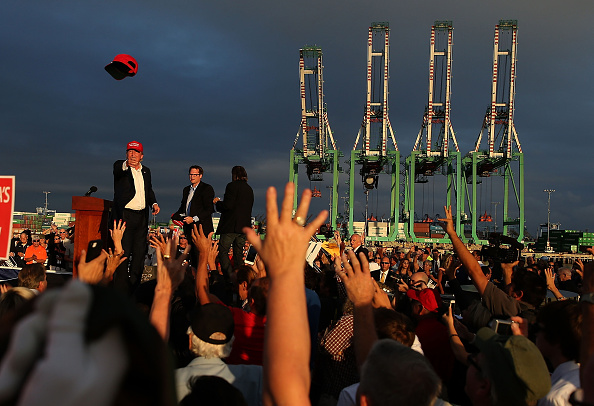
It also emerged as an American emblem to turn upside – and backward.
"When I think of the baseball cap backward," Givhan said, "I can always hear a parental 'tisk-tisking' and a 'turn your cap around.'"
It's almost a subversion of the cap's ideal as "clean-cut," she said.
And breaking the rules is exciting, especially if you're still living in a house under someone's else rules. So the backward cap remains a fashionable, affordable rebellion for the teenagers of Everywhere, USA.
A team of one
In 1996, one phone call to New Era revolutionized the cap industry. Director Spike Lee rang to find out if they could make him a red Yankees cap to match his red Yankees jacket.
That one successful request launched a new era of customization for the industry.
Today, New Era offers 6 billion different types of caps.
You read that correctly.
That's almost 20 times more options than there are people in the United States.
The cap is no longer just in fashion. It is fashion. Look no further than today's magazine stand: Academy Award-winner Anne Hathaway posed in a New York Giants football cap and a diamond bracelet for the cover spread of April's Elle.
The hat does mean something different on each head. For Chance the Rapper, he says his signature "3" cap represents defiance. He can no longer be told what to do, including that he should take his hat off. For Trump, his trademark "Make America Great Again" hat was a rallying cry for the common man on the campaign trail.
Yet, it's a strange impulse we have, Thorn said, "that's driving us to use the same thing to assimilate and distinguish ourselves."
Baseball players are no different
Rick Stowe, the clubhouse and equipment manager who has been with the Reds since 1981, said that players often personalize their caps by writing on the inside of the panels. They might write scripture or the names of their children or reminders for the game.
Relief pitcher Drew Storen will cut the back band of his cap oh-so-slightly so it will sit just oh-so-low enough. Just like he likes it.
There are no requirements or guarantees on how many caps a player can or must wear during the season. So when Stowe orders for the season, he's got to guess. This year, that's 1,956 for the total team for the whole year.
For outfielder Scott Schebler, he'll go through maybe six hats a year. Shortstop Zack Cozart can't remember switching out a hat, he said. "My thing is, once I found one that’s comfortable and feels good on me, I just like to keep it," he said.
But Cozart must break in more than one each season. The Reds will wear 15 to 20 different uniform types this year, including themed ones for Father's Day, Memorial Day and Fourth of July.
The hat's the same, there are just more versions than ever, Stowe said.
This year's slight adjustment? You'll see the New Era logo on the on-field caps this Opening Day. And they are all on sale at the gift shop, too.
Despite its diverse designs, myriad meanings, there is still one place you might never see the official Reds cap.
That's a Reds player’s head after the end of the ninth.
"You won’t find a Reds player wearing a Reds hat at Kroger," Cozart said.
He's not exactly sure why. It was just kind of instilled in you as you went up through the minors, he said.
Or maybe it's because even after 168 years, the baseball cap is still what he wears to work.

